
The First and Only Weekly Online Fanzine Devoted to the Life and Works of Edgar Rice Burroughs |

The First and Only Weekly Online Fanzine Devoted to the Life and Works of Edgar Rice Burroughs |
|
|

 |
    
CHATTERING FROM THE SHOULDER #23 John Coleman Burroughs'
|
 |
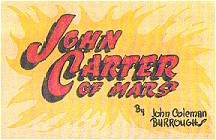
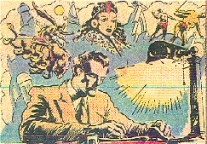
Chapter Summary
by
Nkima
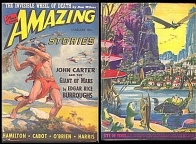
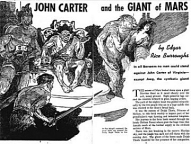
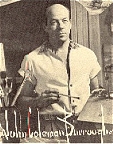
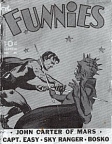
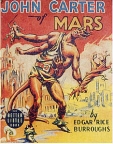
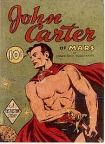




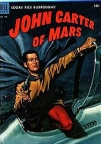
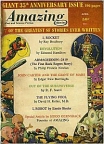
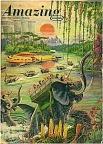



 |
Publishing History
This story was written by John Coleman Burroughs. It first appeared as a Big Little Book story in 1940. The text followed in the summary below was published in Amazing Stories Quarterly, Volume 1, no. 4 fall 1941. It was reprinted in Amazing Stories, January 1964. The first book edition of this tale was Canaveral Press, Inc., July 24, 1964. The first paperback edition was by Ballantine Books, April 1965. The story was written in 14 short chapters. Chapter One: Abduction
Chapter Two: The Search
Chapter Three: Joog, the
Giant
Chapter Four: The City
of Rats
Chapter Five: Chamber of
Horrors
Chapter Six: Pew Mogel
Chapter Seven: The Flying
Terror
Chapter Eight: The Reptile
Pit
Chapter Nine: Attack on
Helium
Chapter Ten: Two Thousand
Parachutes
Chapter Eleven: A Daring
Plan
Chapter Twelve: The Fate
Of A Nation
Chapter Thirteen: Panic
Chapter Fourteen: Adventure's
End
|
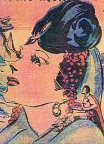
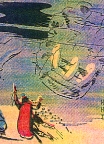
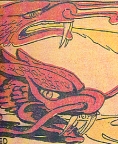
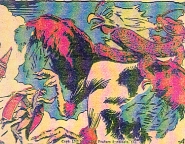
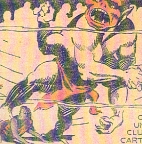
Nkima's Essay
Jack Carter and the Giant

|
Maybe I'm not enough of a purist, but I rather enjoyed
John Carter and the Giant of Mars. It may not have
come from the pen of the Master, but it is certainly a good story in ERB's
Wonder Realm. His son obviously knew what he was about in creating
this clever, little fairy tale.
I'm not about to question the existence of three-legged rats on Barsoom. Maybe they are not exactly Ulsios, but they do give one pause as to their exact method of locomotion. Where is that third leg located on the body anyway? I picture them as hobbling about like broken mechanical toys wondering where God or Pew Mogel has gone wrong in his evolutionary plans. Kangaroos get around pretty well on two legs, so maybe they hop a lot. I think JCB was pulling our leg with this one. Edgar Rice was given to exaggeration at times, and his son followed suit. Joog is a 130 foot tall giant -- much more than the one met by Jack The Giant Killer, who was only eighteen feet high. Burroughs is fond of writing about giants. Tarzan himself is often described as a giant man, and the green men of Mars are giants compared with normal human beings. Tarzan is a giant when he first meets the Ant Men. I don't think that JCB was too far from his father's way of thinking when he wrote about Joog. The entire story is a hoot: Pew Mogel riding around on the head of Joog in a howdah, truly acting like a Mogul on an elephant: the 2000 rats in parachutes scaring away the birds who carry an army of white apes. This is wonderful Oz stuff like so much of Burroughs in fact truly is. JCB didn't have recurring nightmares so far as we know, but he must have heard some great bedtime stories when he was a boy. Unlike Odysseus, Carter treats the giant with some respect. Odysseus finds it necessary to put out the single eye of Polyphemos to escape from his cave, while in the Carter account it is the eye of Pew Mogel that keeps on falling out, so he is in effect the man with a single eye. Pew is slain, while Joog goes free. (For an interesting account of this theme I refer you to "Origins of the Sacred" by Dudley Young, who believes that the charges of cannibalism against Polyphemos are trumped up ones since he was clearly a shepherd who lived on milk before Odysseus came along.) Joog doesn't loose his head like Pew Mogul. He just gets to go back home and wanders around in the dead city of Korvas, perhaps talking on the loudspeaker in Pew's throne room, wondering where the Wonderful Wizard has gone. The giants in myths and fairy tales do usually like to eat people. The Cyclop in Homer's Odyssey did partake of man-meat, as Pope so aptly describes the gory feast: " . . . his bloody hand Snatch'd two, unhappy! of my martial band; And dash'd like dogs against the stony floor: The pavement swims with brains and mingled gore. Torn limb from limb, he spreads his horrid feast, And fierce devours it like a mountain beast: He sucks the marrow, and the blood he drains, Nor entrails, flesh, nor solid bone remains." In Jack and the Beanstalk we all recall the familiar refrain: "Fee, Fi, Fo, Fum,
I was a little taken aback that Joog did not want to eat anyone, but I suppose being created from the flesh of 10,000 red men and white apes does have its effects on normal giant behavior. I suppose the City of Rats was gruesome enough for a Big Little Book in 1940. I know that my mother never read it to me. The rats do act like giants in that they have lots of human bones lying around. Jack the Giant Killer finds human skulls and bones all over the floor of Old Blunderbore's castle. King Rat loses his head to Jack Carter's sword, as does Pew Mogel. This is a particularly good way to finish off giants, as David in the 17th chapter of first Samuel knew when he lopped off Goliath's head after he knocked him out with a stone. Like a good giant, Joog carried a club, or a tree trunk. No sub-machine guns for him. Jack the Giant Killer met the type: "Though here you lodge with me this night, You shall not see the morning light; My club shall dash your brains out quite." There are indeed mutilations galore in giant stories. Pew Mogel threatens to chop off Dejah Thoris's fingers, and the bandaged heads of the white apes tells of frightful operations. There is also the matter of giants dragging off their victims by the hair or hanging them by the hair in their castles, which occurs time and again in Jack The Giant Killer. Jack Carter is not treated this way, but he is cruelly grabbed by the hair and jerked into a cage by one of the white apes, so the theme is given its fair play. The caged victim is also a theme in Jack The Giant Killer. He frees the captives, feeds them with the giant's own fare, and divides the giant's treasure among them. He has the advantage of an invisibility cloak that is used to good effect in another Martian tale mentioned below. Many accounts of Jack
and the Beanstalk and Jack the Giant-Killer may be found at:
Chapter six, verse four, of Genesis in the Bible records that "There were giants in the earth in those days; and also after that, when the sons of God came in unto the daughters of men, and they bare children to them, the same became mighty men which were of old, men of renown." These "giants" were actually angels. One of them, Shemhazai, had two monstrous sons named Hiwa and Hiya whom daily ate a thousand camels, a thousand horses and a thousand oxen. These giants were called The Fallen Ones who later took to dining on human flesh. When God decided to wipe them out in Noah's flood, they were so tall that they stood above the waters, but they starved to death. This story is found in "The Hebrew Myths: The Book of Genesis" by Robert Graves and Raphael Patai. The authors reckon that the Hebrews were encouraged to form legends about giants when they found megalithic monuments in Canaan. So too were formed Greek legends of giants by story-tellers ignorant of ramps, levers, and other Mycenaean engineering devices when they saw the walls of Tiryns, Mycenae and other ancient cities. This account seems rather disingenuous to me since it discounts the psychological meaning giants hold in the human psyche. Another Talmudic source reveals that the giant sons of Shemhazai were named Og and Sihon, which may account for the naming of Joog. This Og escaped from Noah's flood by riding on the roof of the ark hidden under a gutter. (C.J. Jung, Psychology and Alchemy, pages 460-1.) Og was also the King of Bashan and was later killed by Moses. Jung goes on to explain that Og and the unicorn are reminiscent of Behemoth and Leviathan -- personifications of the daemonic forces of nature. (Jung, 464). So what is the meaning of the ubiquitous giant image in the realm of fairy tales? Bruno Bettelheim in his The Uses of Enchantment tells this mother's story. " . . . she told him the tale of "Jack the Giant Killer. His response at the end of the story was: "There aren't any such things as giants, are there?" Before the mother could give her son the reassuring reply which was on her tongue -- and which would have destroyed the value of the story for him -- he continued, "But there are such things as grownups, and they're like giants." At the ripe old age of five, he understood the encouraging message of the story: although adults can be experienced as frightening giants, a little boy with cunning can get the better of them." (Bettelheim, 27). Whatever Oedipal conflicts may be involved with JCB's version of the giant, Joog, they are somewhat mitigated by his final banishment to a dead city rather than the punishment meted out by Jack the Giant Killer, which most often involved decapitation and/or dismemberment. A comparison of Joog and Ghron, the Spider of Ghasta in The Fighting Man of Mars might be made. Ghron was a giant who looked like a huge, black hairy ape. He lived in a black castle and was given to mutilation of his victims which involved torture and grilling. Like Jack, Hadron moves about with the use of an invisibility cloak, and he is held in an iron cage. Ghron is not punished for his wickedness, but Hadron's escape is effected in a hot air balloon filled with the heat from Ghron's smoking chimney. Most stories about giants are closely linked with acts of dismemberment and a form of ritual cannibalism. The stories, at least in those by Burroughs, may be linked with a kind of ritual dance that leads to a change in the power structure among a given group of primitive creatures. Tarzan kills his ape father, Tublat, after a struggle over the dismembered ape (a Bolgani, which is a gorilla, the giant of the ape family) at the ring-dance of the Dum-Dum in chapter seven of Tarzan of the Apes. Here Burroughs makes a bold statement concerning the Dum-Dum. "From this primitive function has arisen, unquestionably, all the forms and ceremonials of modern church and state, for through all the countless ages, back beyond the last, uttermost ramparts of a dawning humanity our fierce, hairy forebears danced out the rites of the Dum-Dum to the sound of their earthen drums, beneath the bright light of a tropical moon in the depth of a mighty jungle which stands unchanged to-day as it stood on that long forgotten night in the dim, unthinkable vistas of the long dead past when our first shaggy ancestor swing from a swaying bough and dropped lightly upon the soft turf of the first meeting place." From this statement one might believe that Burroughs had read Sigmund Freud's Totem and Taboo and ascribed to his theories of the primal horde. Dudley Young in his Origins of the Sacred, his search for the origins of human religion, also follows this line of reasoning, linking a dismemberment dance to the rise of the alpha-shaman -- the first priests. So too, Frazer discovers in his The Golden Bough links between religion the burning of giant figures enclosed in wicker cages among the Druids during fire-festivals, which have continued to the present day in the spring and midsummer festivals of Europe. Frazer ascribes all of these cases as a primitive method of eliminating spells and witchcraft, which might be transformed in the case of the JCB story into the dark science of Pew Mogel, who performed unnatural experiments upon men and animals. Frazer also notes that giants, or tall men in masks to represent demons, are employed by some primitive peoples in the initiation ceremonies of boys entering puberty. These boys are ritually killed and eaten, then return to their people as transformed men of the tribe. Thus, the fairy tale story of a giant even in the Big Little Book version of John Carter and the Giant of Mars, one presumably written for children, provides us with a story of coming of age. ~ Nkima ~ October 20, 2000
|
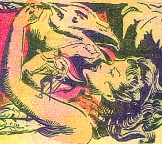
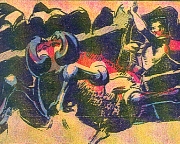
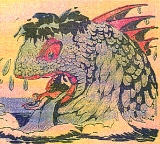
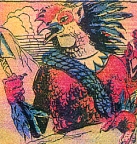
Nkima Chattering From The Shoulder
Read 'em all at:
www.ERBzine.com/adams
